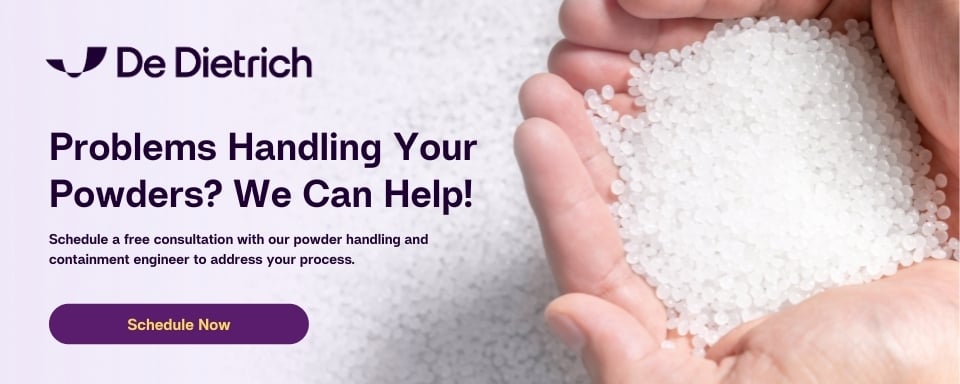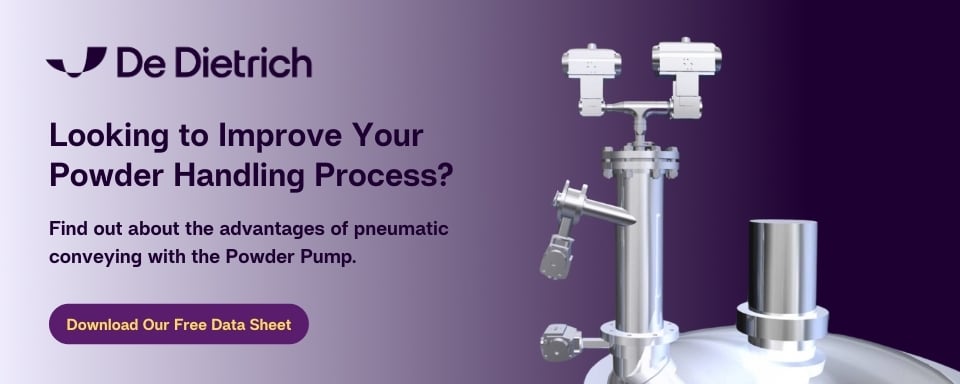5 Reasons to Improve the way you Transfer Powders
 If you have an application in your facility that involves the handling of powder, there is a good chance that there is a better, safer, and more efficient way in which the material can be moved than the current method. To help find out, we’ve put together a short questionnaire. Ask yourself the following questions:
If you have an application in your facility that involves the handling of powder, there is a good chance that there is a better, safer, and more efficient way in which the material can be moved than the current method. To help find out, we’ve put together a short questionnaire. Ask yourself the following questions:
-
Are you looking to move or charge a powder and create less dust while doing so?
-
Do you want to improve how you presently move powders?
-
Are you exposing employees to the hazards associated with powders?
-
Are you carrying bags of powder around your plant that can lead to potential personnel injuries?
-
Do you have a lot of labor tied up moving powder?
-
Do you have safety concerns about powder conveying and static generation?
If you answered “no” to all of the above questions then, congratulations! You and your company are doing a stellar job at employing all the latest technologies to keep your process up-to-date and maintain a safe working environment for all employees. However, if you answered “yes” to any of the above questions then join the majority of people that could use some process optimization!
There are several transfer methods for moving powders, each with its own unique benefits and drawbacks. The most basic of these methods is manually charging powders. Manual charging of powders into reactors and other equipment remains a common practice at many facilities where processes that involve solids handling are being performed. This method has been used for decades and its main advantage is that it does not require any expensive equipment or sophisticated controls. However, there may be other considerations that would make changing to a more automated method advantageous. We cover some of these further down in this post...
Mechanical transfer is another option that is relatively inexpensive and can add automation to your process through the use of energy efficient motors. However, the routing for the required pipeline can often make installation difficult and issues with containment and operator exposure are still present.
A third option is pneumatic conveying, which provides a fully-automated solution that offers the highest level of containment. There are two main objectives to containing powder, both of which are especially important in pharmaceutical and fine chemical applications– keeping the product safe from the environment and keeping the environment (and those people working in it) safe from the product. Depending on the characteristics and toxicity of the product, one or both of these objectives must be met to ensure the high standards of product quality and operator safety. Pneumatic conveying is the best technology to use to ensure a closed system is maintained.
Here are some key reasons why pneumatic conveying is advantageous over other methods of transfer.
1. Operator and Environmental Health and Safety
Operator ergonomics is intentionally the first item on our list because worker safety should be the primary concern for any company. A process that involves the handling of a hazardous material introduces increased safety risks to the operating personnel. Contained transfer of powders effectively decreases the manual handling of solids, therefore reducing operator exposure to the product being transferred. Additionally, the pneumatic conveying of powder into a vessel versus manually dumping heavy containers eliminates the risk of operator back injury. There can also be cost saving realized, since it is no longer necessary to purchase expensive personal protective equipment (PPE) given the high level of containment that can be achieved.
From an environmental perspective, the closed system that is created via contained transfer provides a dust-free atmosphere. In the case of powders with a chalky consistency, this helps to maintain cleanliness of the facility, but even more important, in the instance of products containing carcinogens or materials with sensitivity to oxygen, the inert environment that is made possible helps to promote the health and safety of the work environment as a whole.
2. Cleanliness of Plant and Equipment
Pneumatic transfer can help to establish good housekeeping practices in a production facility. The equipment is typically much easier to clean than mechanical equipment. The closed system that is achieved eliminates exterior contaminants, substantially reducing equipment and facility clean-up.
3. Process Efficiency
The efficiency of a process plays an important role in determining variables such as transfer capacity, rate, and distance, all of which can positively or negatively affect batch time. The improved agitation due to controlled material addition significantly decreases batch time. Additionally, contained transfer provides the ability to charge powder into a vessel under pressure or vacuum, or with liquids (including solvents) present in the vessel. This capability enables the safe handling of hazardous and toxic products including carcinogens, oxygen or skin sensitive materials, and even explosive powders. Less manpower is required to charge the vessel, freeing up employees to manage other important work tasks. Additionally, pneumatic conveying equipment is more streamlined, so hoists and handling equipment over the reactor are no longer required.
4. Equipment Life
Being able to keep a vessel closed while introducing powder into the process is an ideal practice to follow in any application (general rule of thumb – keep the manway closed whenever possible!). Pneumatic transfer eliminates the need to open the manway, preventing the risk of damage and deterioration. Since the charging of material is carefully controlled using this method, the agitator and seal system remain protected from deflection or damage that can sometimes occur when solids are overcharged during mixing or when the agitator is started in excess solids. Overall, equipment maintenance is substantially reduced as a result of the closed system that is created.
5. Product Quality
There are numerous advantages to pneumatic conveying related directly to product quality. This aspect is extremely important in pharmaceutical applications where product integrity is critical. A closed environment effectively diminishes exterior contaminants which can otherwise jeopardize the purity of an entire batch. Depending on the product, a contaminated batch could be a very costly mistake. It is important to note that product quality through contained transfer can be accomplished at any product phase – raw ingredients, intermediate powders and/or finished products.
If your facility is currently handling powder manually or mechanically and doing so in a potentially unsafe method, it is important to explore the option of contained transfer. When looking at equipment procurement expenses compared to the potential risk of operator injury, it’s clear to see that the option to pneumatically charge powder is a viable one. Learn about the various benefits of DDPS’ Powder Pump, a technology that allows you to convey your powder safely and easily.

